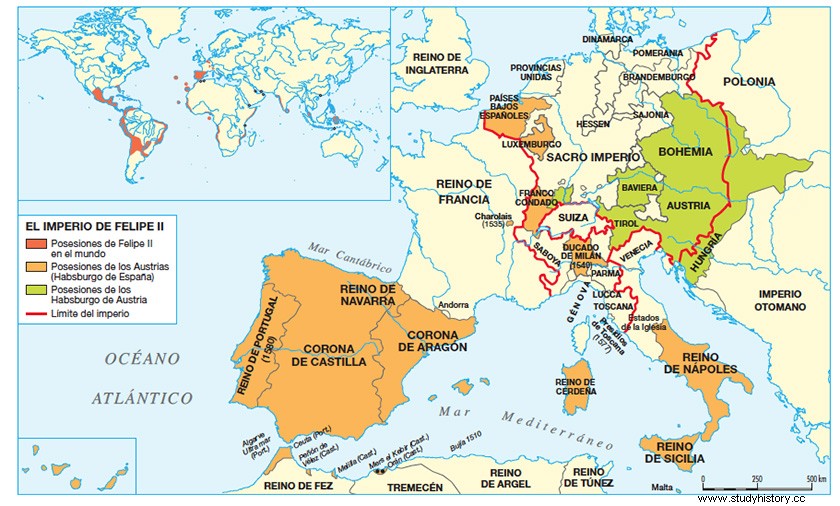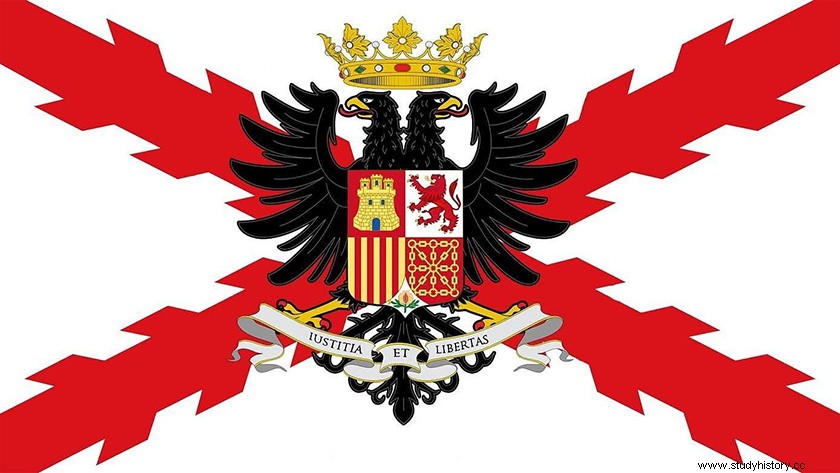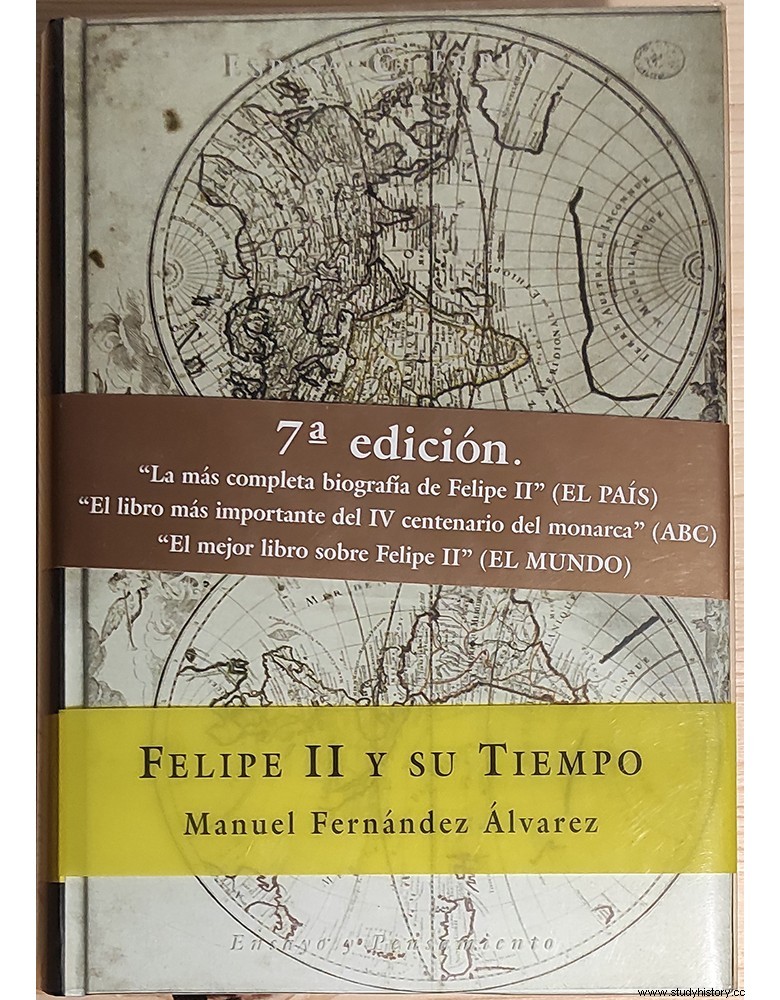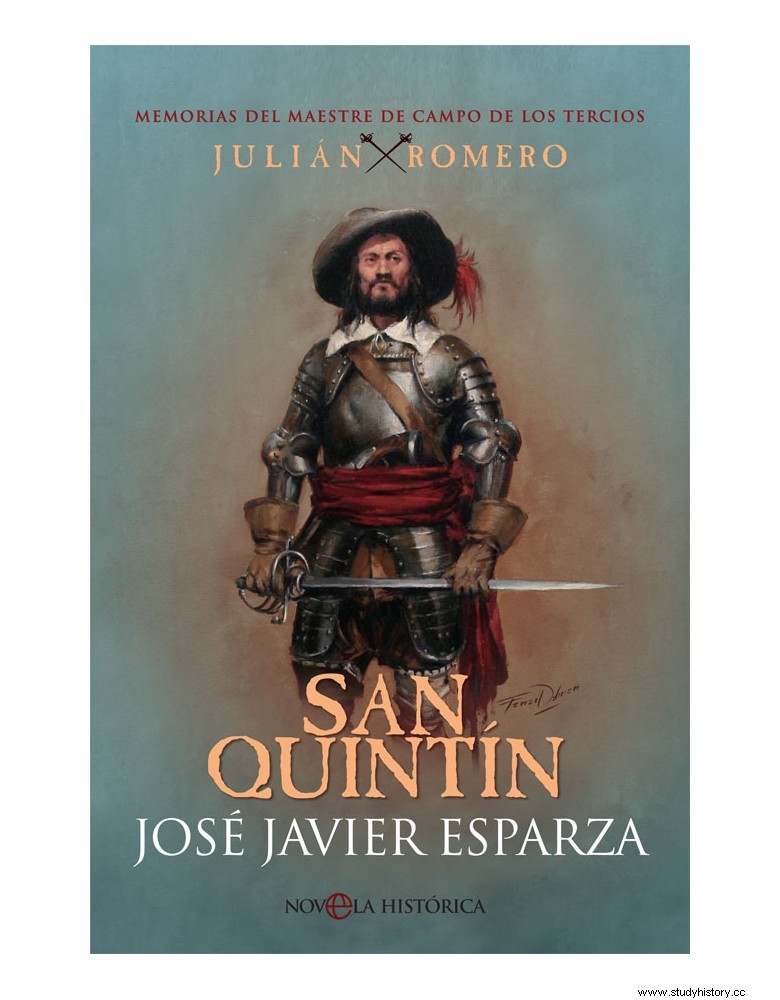
In the late 16th century, Philip II , after being crowned king of Portugal, in the midst of the 80-year war, he had under his power one of the largest empires in history. At that time his royal possessions occupied part of the four known continents, Asia, America, Africa and of course Europe. It is evident that in such vast territories the conflicts followed each other, and no matter how much I wanted to, it was impossible to go and suffocate them all. But no matter how many kilometers away some possessions were, none gave him the headaches that this little corner of Europe. In short, Flanders, according to the great analysts of modern history, was to blame for the fact that the Spanish Empire ended up succumbing, in importance, to its great rival, England.

The empire of Felipe II, during the war of 80 years.
One of the richest corners of Europe.
Flanders, also known as the Netherlands, occupied a space very similar to the current Benelux in the 16th century. Specifically, we can speak of 17 provinces, with a great degree of autonomy, which led them to be governed as small independent kingdoms. Thanks to being in the middle of the great commercial routes between the Atlantic, the Baltic, Europe and England, its commerce, its banking and especially its textile production, led it to be one of the richest areas of the continent. In addition, culturally they were at the top of the ladder, the Flemish painters or Erasmus of Rotterdam are examples of well-known leftovers.
Well, Flanders was incorporated by Philip “the good” to the Duchy of Burgundy in 1428. Hence, after the wedding of Juana “la loca”, with Felipe “the beautiful”, This rich territory entered fully into the orbit of Spain, since her son Carlos, born in Ghent, will become heir to these territories. After the departure of the latter from Flanders, to take charge of his territories in the Peninsula, he left the government of the 17 provinces in the hands of women, his aunt Margarita de Austria , and her sister Maria of Hungary . Both carried out important reforms to provide these territories with broad levels of independence, specifically the Council of State became their most important political body. In exchange, these territories agreed to help defray the important expenses of the Empire of Carlos V.
A religious issue that masks the real problem.
The problems begin after the abdication of Carlos V in his son Felipe II, if the first was seen as a compatriot, the second was a foreign king. In addition, Felipe II was in full discussion of the Council of Trent, where he was proclaimed defender of Catholicism, against the protestant current that was permeating the different European countries. The first steps of him; place Granvela , a character from Franche-Comté, as president of the Council of State of Flanders, establish new bishoprics, and introduce the Inquisition in the Netherlands. Evidently the response was immediate, a request by the members of the Council to withdraw the new president, an aspect granted in 1664, and above all freedom of worship, Philip II no longer passed through there.
The riots began in 1566, with various demonstrations and looting of Catholic churches such as Tounai or Antwerp. The background would be religious, but the reasons were clearly of another nature:the aspiration for greater autonomy, by a society that wanted to maintain its laws and customs. But above all the desire of the nobility to maintain their status, it is not difficult to imagine the difficulties of some Catholic merchants, surrounded by Protestant countries:Lutheran Germany, Calvinist France or the England of Elizabeth I.
Philip II sends the first army to pacify the Netherlands, made up of 10,000 soldiers, known since then as the “Flanders Thirds ”. They left from Milan, and crossed all of Europe to open the so-called "Spanish road", through their own territories of Savoy and Franche-Comté. Commanded by the Duke of Alba, who did not cool his pulse upon his arrival in Flanders; with executions of the nobility after the establishment of the Court of Tumults, which held the power to judge crimes against the Spanish Crown. An error that will be paid dearly, by creating a feeling of rejection, even greater than the previous one. The war was served.

Flag of the Thirds of Flanders
The beggars of the sea and the thirds stuck in the mud.
Faced with the great repression exerted by the government of the Duke of Alba (1567-1574) the Flemish begin to organize:two brothers will become the leaders of the resistance; William of Orange forced in the first stay to emigrate to Germany, where he will begin the recruitment, and Luis de Nassau , the latter with important contacts between the French Huguenots, which will interrupt trade and the arrival of troops in the La Rochelle area. If the maritime south was controlled by the Huguenots allied with the Flemish, in the north the so-called "beggars of the sea" will become strong, pirates who will dedicate themselves to sabotaging the arrival of Spanish ships, the latter will take the port of Brielle (Zealand), as a starting point for the land conquest.

William of Orange
Things weren't easy either, the Flanders ground is flat and full of rivers everywhere, and there were also a lot of fortresses that had fallen into the hands of the rebels. The Tercios were forced to long days of siege, which weakened health in those marshy lands. An army prepared for a face-to-face encounter, which meant an enormous expenditure of men and money for the Spanish Crown, and which did not bear the desired results.
Faced with zero progress, Philip II decides to change direction. He dismisses the Duke of Alba and puts Luis de Requesens in his position. (1574-1576), with a more negotiating mood. But with the same result, the rebels from the north continue to conquer ports, the new governor is unable to control the Spanish troops, who, without charge, after the Spanish bankruptcy of 1575, loot the city of Antwerp, producing a large number of dead. One of the proposals of Luis de Requesens made Felipe II tremble, given the impossibility of controlling the "beggars of the sea" he urges to bomb the containment dykes of the Atlantic, to flood the entire north of Flanders, Felipe II refused.
The time of Alexander of Farnese
After the death of Luis de Requesens and the unsuccessful peace attempts of his replacement John of Austria, in 1579 Alexander of Farnese became governor. A great diplomat who obtained the submission of some of the southern provinces with a Catholic majority, to sign the Union of Arras . The response was immediate, only three weeks later the Union of Utrecht was born. , embryo of the current Netherlands, especially after the Abjuration Act of 1581, by which these seven northern provinces, with a Protestant majority, definitively broke with the reign of Felipe II. Although it will take many years to be recognized by Spain, the United Provinces, or Holland, as we prefer, it begins to function as an independent country.

Moving away from Farnese
Alexander Farnese also excelled in the military field, commanding the Flanders Tercios, conquering the rest of the southern cities; Ghent, Bruges, Brussels and finally Antwerp after a very long siege. He also made great progress among the cities of the newly emancipated north, that is, over the Dutch territories; him conquering Eindhoven, Breda or Nijmegen. But for total conquest, control of the sea was necessary, and this was in Dutch and English hands, the latter willing to intervene to protect their new partner, and in the process punish their great rival in the colonial world, Spain. While the English pirates, commanded by Drake punished the Spanish ports, Felipe II prepared his Great Armada to reconquer the English Channel.
As is known Philip II did not achieve his purpose, nor did he control the sea, nor did he reach the English coast. In case something was missing, Alejandro Farnesio died in 1595, possibly without other open fronts this general would have ended up subjugating the Netherlands. Obviously it was not like that, at the end of the 16th century Spain had three powerful rivals, France, England and the new Holland. Before Felipe II died, in 1598, he had only agreed on a sad Peace of Vervins with the French.

The Netherlands at the end of the 16th century, during the 80 years war.
Path to an inevitable truce.
Felipe II is succeeded by his son Felipe III . The latter practically inherited the Empire from his father, but he also inherited an economic crisis that was difficult to solve, since only two years had passed since the last bankruptcy. Hence, sometimes we can discuss the vision of pacifists that historiography has granted to Felipe III, and the faithful value of him the Duke of Lerma , if the coffers of the crown had been full, surely the story would have been different.
The substitute for the ousted Alejandro Farnesio was the Archbishop of Toledo, who after the death of Felipe II will abandon his habits to marry his cousin, and daughter of Felipe himself, Isabel Clara Eugenia . Both acquire in this way the Catholic part of the Netherlands, to become sovereign and start a path towards peace. The Spanish Tercios did not abandon the place, they remained as guarantors and protectors before the neighbors to the north. Now yes, the one known as the Archduke Albert of Austria initiates contacts with England to seek a consensus.
But at the same time that the Archduke sought and signed peace in England, Ambrosio Spínola a Genoese in the service of the Spanish Crown decides to resume the war on his behalf. In command of the Tercios he conquered Ostend and Daventer between the years 1604-1605, the campaigns were recounted by victories. Without the maritime aid of England, hopes are recovered.
But a new bucket of cold water fell on the hopes of the Spanish Empire. Although Spínola's plan was good, cutting the aid lines to the Dutch from their Lutheran partners in Germany, the umpteenth crisis of the Indies campaigns, left the coffers empty to pay the thirds. They mutiny and the Dutch troops of Mauritius of Nassau they defeat the few available thirds, who were paid by Spínola himself. With no solution of continuity, the truce is the only valid path for Spanish interests, waiting for better economic times. Thus the twelve-year truce was born.
Europe and the Atlantic become a tinderbox.
In 1618, three years before the truce in the Netherlands expired, one of the most violent wars Europe had to endure broke out. The 30-year war , between Catholics and Protestants in the Holy German Empire, which will affect all the European powers, and in return will enter fully into the Spanish conflict in the Netherlands. Given what was expected, Spain decided to take action, and in 1620 a Spanish army under the command of Spínola, took up positions in the Palatinate. Its position was strategic, both to prevent aid to the Dutch from Germany, and for the passage of Spanish troops in order to conquer the north of the Netherlands.

The other parallel war, that of 30 years.
Before the end of the truce, there is a change in the Spanish Royal House. Felipe III dies at only 42 years old, his position is occupied by a 16-year-old boy, Felipe IV , which he leaves in the hands of the Count-Duke of Olivares the designs of Spain. The latter imposes his decision, before that of Archduke Albert of Austria, to resume the war in the Netherlands.

Count-Duke of Olivares
As soon as the conflict resumed, the South Atlantic also became the scene of the 80 Years' War , the Dutch took advantage of the truce to strengthen their maritime position. Fortunately for Spanish interests, the Peace of London of 1604 , between Spain and England, acted as a stopper for English aid in the English Channel. To this aspect came to add the good campaigns in the metals that arrived from America, for which Spain managed to reinforce the fleet, and exercise a certain maritime control from Dunkirk, to supply the Spanish Tercios in the south of the Netherlands.
The same did not happen in the south of the Atlantic, there the Dutch managed to take the port of Bahia, in Portuguese Brazil, it is necessary to remember that it belonged to the Spanish Empire since the time of Felipe II. His intention was clearly to cut off the supply of silver from America, without money, Spain was more vulnerable in the Netherlands. At first it did not happen that way, rather the contrary, in October 1624 one of the most important remittances in history arrived in Spain, only a few months later the Spanish Tercios took Breda, without a doubt one of the most significant cities of this war, due to its border position and its Catholic majority. But the Dutch plan paid off in 1628, when they neutralized the output of Spanish metals in the Cuban city of Matanzas, a new break in the war was the result.

Replica of a 17th century Spanish Galleon, in New York Bay
France and internal problems, new rivals.
At this point we can take the sentence for granted; "Never has a great victory tasted so much like defeat." The death of the Archduchess Isabel Clara Eugenia in 1934 led to the appointment of the Infante Don Fernando as Governor of the Netherlands. To go to his new position, he puts himself at the head of the Spanish thirds to defeat the Swedes in Nördlingen , battle belongs to the parallel war of 30 years, which meant to regain control of the routes from Milan and Germany to Holland.
But it also meant the arrival in the conflict of one of the most sinister characters of the Modern Age, Cardinal Richelieu . His intention is to end the Spanish Empire, which is why he doesn't mind putting France in all the European conflicts. His pacts with Holland, Sweden, the Saxon princes, or Catalans and Portuguese in the Iberian Peninsula, reduced Spain's ability to control the Netherlands, all lines of communication were in danger.
Certainly from that point, we witness a continuous decline, the loss of Breda is also significant, as well as the sieges suffered by Spain in the peninsula, Hondarribia, Catalonia or Portugal. The fall of trade with the Indies by the Dutch pirates aggravates the situation, which triggers one of the resounding defeats of the Spanish Tercios, the magnified defeat of the Battle of Rocroi in 1643 . It is true that the opportunities to control the Netherlands began to decline, but the south remained controlled until the end of the war, which is considered a titanic effort for 80 years, which will take a huge toll on the Spanish Empire. 
Rocroi, the last third, by Augusto Ferrer Dalmau
The peace of Münster before Westphalia.
In January 1648, in Münster Spain had recognized the independence of the United Provinces of the North. But she had managed to hold the southern provinces at least for the time being. Months later in Westphalia the joint peace of both wars is signed, that of the 1980s and that of the 1930s. A new Europe had just been born, from that moment on the excuse for war will be different; we'll put aside religion and put up a flag, but that's another story.
Recommended reading:

Buy Philip II the Time of him
C 
Buy Empire

Buy Steel and Glory

Buy San Quentin
The Modern Age (15th-18th centuries), Luis Ribot, Ed. Marcial Pons, 2016
From Pavia to Rocroi, the Spanish Tercios, Julio Albi de la Cuesta, Ed. Balkan Editores, 1999
